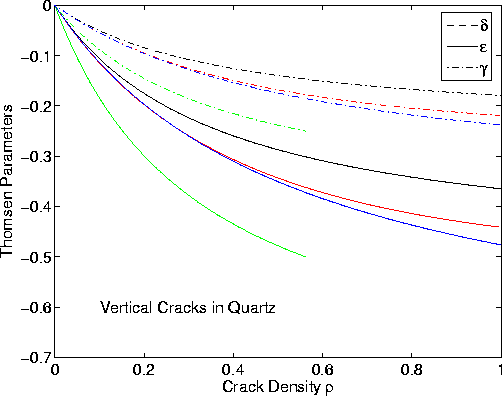There are three Thomsen parameters: ![]() ,
,![]() , and
, and ![]() . Parameter
. Parameter ![]() is essentially the fractional difference between
the SH-wave velocities in the horizontal and vertical directions for a VTI
medium. Similarly, parameter
is essentially the fractional difference between
the SH-wave velocities in the horizontal and vertical directions for a VTI
medium. Similarly, parameter ![]() is essentially the difference between
the P-wave velocities in the horizontal and vertical directions.
Parameter
is essentially the difference between
the P-wave velocities in the horizontal and vertical directions.
Parameter ![]() is more difficult to interpret, but contributes
in an essential way both to near vertical P-wave speed variations,
and also to the angular dependence of the SV-wave speed.
There are a great many steps that go into Thomsen parameter
calculations since the crack density effects are most conveniently
expressed in terms of the
compliance matrix while the Thomsen parameters are usually defined instead
in terms of the stiffness matrix (inverse of the compliance matrix).
I will not show my work here, but merely quote the final result
for the case of randomly oriented vertical fractures considered
in the previous subsection.
is more difficult to interpret, but contributes
in an essential way both to near vertical P-wave speed variations,
and also to the angular dependence of the SV-wave speed.
There are a great many steps that go into Thomsen parameter
calculations since the crack density effects are most conveniently
expressed in terms of the
compliance matrix while the Thomsen parameters are usually defined instead
in terms of the stiffness matrix (inverse of the compliance matrix).
I will not show my work here, but merely quote the final result
for the case of randomly oriented vertical fractures considered
in the previous subsection.
For present purposes, I just want to show
in a quick way how this method works, so I will concentrate on
the easiest two parameters which are ![]() and
and ![]() . For
these two parameters, I have the following results:
. For
these two parameters, I have the following results:
| |
(4) |
| |
(5) |
|
thomsenALLv
Figure 2 Computed values of the Thomsen parameters |  |
Examples of Thomsen's parameters for various choices of EMT
are displayed in Figure 2. The results illustrate how estimates of
![]() and
and ![]() obtained from four different isotropic estimation
schemes [noninteracting, DS (Zimmerman, 1991),
CPA (Berryman, 1980), and nonsymmetric self-consistent scheme of
Budiansky and O'Connell (1976), and O'Connell and Budiansky (1977)]
can then be used to predict
what values Thomsen's parameters should take in field data.
obtained from four different isotropic estimation
schemes [noninteracting, DS (Zimmerman, 1991),
CPA (Berryman, 1980), and nonsymmetric self-consistent scheme of
Budiansky and O'Connell (1976), and O'Connell and Budiansky (1977)]
can then be used to predict
what values Thomsen's parameters should take in field data.
Some judgment is required then as to the most appropriate EMT to use, and prior work shows that some knowledge of microstructure can serve as a very useful guide when making this choice (Berge et al., 1993a; 1995).